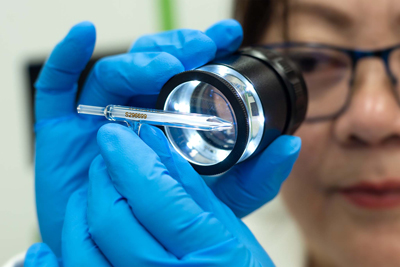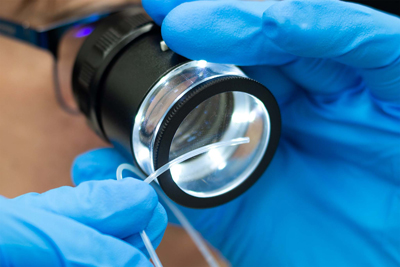
 |
CHINESE |  |
ENGLISH |  |
FRENCH |  |
GERMAN |  |
ITALIAN |  |
JAPANESE |  |
RUSSIAN |  |
SPANISH |  |
| mail this page to a colleague | |||||||||||||||||

|
|||||||||||||||||
|
| HOME | PRODUCTS | SEARCH | SHOPPING CART | NEWS | ABOUT US | DISTRIBUTORS | CONTACT US |
HF (hydrofluoric acid) should not be used with glass or quartz. Using any amount of HF will damage the product. Our nebulizers are supplied clean and ready to use. Please do not pre-treat nebulizers with HF.
Apart from the DuraMist, OpalMist and VeeSpray nebulizers, all Glass Expansion concentric nebulizers are made from borosilicate glass or quartz, so you should exercise the same care that you would normally use for glass labware. Treat glass with the care that is due to a brittle material. Glass can fracture and produce sharp, cutting edges, so handle all glass objects with slow, deliberate movements and don't apply large mechanical forces to them.
Take safe care of the nebulizer tips. Don't knock the tip of the nebulizer or leave it unprotected when not in use. Once a nebulizer tip has been damaged, the nebulizer's performance cannot be restored. All Glass Expansion nebulizers are supplied in specially designed plastic boxes. The nebulizer should be kept in this box when it is being stored. This prevents damage to the nebulizer tip, and small particles from lodging in the nebulizer bore and causing blockages.
Never touch the nebulizer tip. Any deposit of body oils can have a detrimental effect on the performance of the nebulizer.
Always start and finish the use of a nebulizer by nebulizing a mildly acidic blank solution followed by demineralized water for a couple of minutes. This ensures that sample deposits or crystals don't form inside a nebulizer when the solvent inside the nebulizer dries out. Don't wash nebulizers in an ultrasonic bath.
If a concentric nebulizer's sample capillary becomes blocked, use the Eluo nebulizer cleaner to clean and unblock the nebulizer. For the OpalMist and DuraMist nebulizers, use the Eluo HF cleaner (P/N 70-ELUO-OPD). For glass concentric nebulizers, use the standard Eluo nebulizer cleaner (P/N 70-ELUO). The Eluo can also be used regularly to clean and maintain the nebulizer. Nebulizer blockages generally occur at the tip and can be difficult to spot. We recommend using the Magnifier Inspection Tool (P/N 70-803-1923) to check for foreign objects, or a build-up of salt around the tip orifice.

If there are salt deposits that cannot be removed with the Eluo, we recommend soaking the tip of the nebulizer in a 25% solution (4x dilution) of Fluka RBS-25 (P/N FLUKA25) or similar surfactant. It should be soaked for 24hrs and then flushed with warm water using the Eluo. After a few flushes with warm water it can then be flushed with methanol so that it will dry faster.
If you find that RSD's are getting worse, but the spray chamber doesn't seem to be at fault, remember to check the vital argon connection to your nebulizer. Tygon or other polymer tubes can sometimes harden over time and lose their flexible gas-tight grip. A small argon leak at this point can often be located by using a meter of soft silicone tube as a stethoscope. Even a 1% loss of argon can produce changes of several percent in many ICP analytical lines. Check the nebulizer uptake too, for possible ingress of small amounts of air.
If you want to know sample uptake, but don't have all the gear to make a weight-loss or volume-loss check, check the speed of a bubble in your uptake tube over a 10cm length. For a 1.0mm ID tube, an air-bubble transiting 10cm in 10 seconds means that your uptake is 0.47mL/min. An air bubble moving at the same speed in a 0.5mm ID uptake tube (a common dimension with GE's nebulizes) means that the uptake is 118 µl/min.
Don't attempt to unblock nebulizers with wires or probes: damage is quite likely to result from doing this.
Sample capillary tubing can often be a source of erratic results when undissolved material in your sample solutions cause a partial blockage, increasing sample back pressure and poor nebulization. At 10X magnification with LED illumination, the small capillary sample tubing can be carefully inspected using the Mangifier Inspection Tool (P/N 70-803-1923) for peace of mind.
